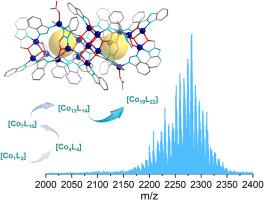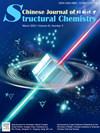Tandem assembly-disassembly-reassembly of hierarchical Co19 coordination cluster facilitated by in-situ ligand transformation: Crystallography and ESI-MS revealed mechanism
IF 10.3
4区 化学
Q1 CHEMISTRY, INORGANIC & NUCLEAR
引用次数: 0
Abstract
Odd-numbered and high-nuclearity coordination clusters are extremely rare, yet they represent an intriguing subclass lacking regular repeating building blocks and high structural symmetry for understanding self-assembled multiatomic systems. Herein, the largest cobalt and polydentate ligand based cluster featuring odd-nuclearity, namely [Co19(HL1)8(L1)12(L′)2(Ac)4]·10CH3CH2OH·6H2O (1, H2L1 = 1H-benzo[d]imidazole-2-yl)methanol, HL' = 1H-benzo[d]imidazole), was obtained with in-situ ligand transformation from H2L1 to L′. It features a hierarchical trilayer and void-cage inside structure, consisting of central disc-shaped [Co7L10] core with two [Co6] rings on both sides. ESI-MS of crystal 1 yields a series of more than sixteen fragments, all featuring an integrated [Co19] core, suggesting stability of the polynuclear cluster in solution. During increased in-source energy from 0 to 100 eV, all MS peaks shifted to a lower m/z range, but the [Co19] core remained intact, excepting for the stepwise elimination of up to three Ac− anions or three L1 linkers. PXRD tracking of the reaction sediments showed the formation of a key precursor of [Co4L4] cubane at 3 h, and its content decreased at 6 h and vanished at 12 h, followed by the appearance of crystals 1 by the generation of a clear solution at 18 h, suggesting an initial cluster assembly-disassembly process. ESI-MS spectra analysis of both reaction sediment and solution further identify the existence of other crucial higher-nuclearity reassembled fragments of [Co7L10] disk and its expansion of [Co13L12(L′)2]. A probable tandem assembly-disassembly-reassembly mechanism is put forward as [CoL2]→[Co4L4]→[Co7L10]→[Co13L12(L′)2]→[Co19L20(L′)2]. Their evolution also indicated the ingenious synergy of coexisting organic, inorganic and in-situ generated ligands, along with diverse coordination geometries of metal ions, plays a directional role in forming odd-numbered and high-nuclearity coordination clusters. Magnetism analysis revealed antiferromagnetic coupling plays dominated role in the cluster.

原位配体转化促进分层Co19配位团簇串联组装-拆解-重组:晶体学和ESI-MS揭示机理
奇数和高核配位团簇极为罕见,但它们代表了一个有趣的子类,缺乏规则的重复构建块和高度的结构对称性,无法理解自组装的多原子系统。本文通过原位配体从H2L1转化为L′,得到了最大的奇核钴多齿配体簇,即[Co19(HL1)8(L1)12(L′)2(Ac)4]·10CH3CH2OH·6H2O (1, H2L1 = 1h -苯并[d]咪唑-2-基)甲醇,HL′= 1h -苯并[d]咪唑)。它具有分层三层和空笼式内部结构,由中央圆盘形[Co7L10]芯和两侧两个[Co6]环组成。晶体1的ESI-MS得到一系列超过16个片段,所有片段都具有一个完整的[Co19]核心,表明多核团簇在溶液中的稳定性。当源内能量从0增加到100 eV时,所有MS峰都移到较低的m/z范围内,但[Co19]核心保持完整,除了逐步消除多达3个Ac−阴离子或3个L1连接体。反应沉积物的PXRD跟踪显示,在3 h时形成了[Co4L4]立方烷的关键前驱体,在6 h时含量下降,在12 h时消失,随后在18 h时产生清澈的溶液,出现晶体1,表明最初的簇组装-分解过程。反应沉积物和溶液的ESI-MS谱分析进一步确定了[Co7L10]圆盘及其膨胀[Co13L12(L’)2]的其他关键高核重组碎片的存在。提出了一种可能的串联组装-拆卸-重组机制:[CoL2]→[Co4L4]→[Co7L10]→[Co13L12(L′)2]→[Co19L20(L′)2]。它们的演化也表明,共存的有机、无机和原位生成的配体,以及金属离子的不同配位几何形状,巧妙地协同作用,在形成奇数和高核配位簇中起着定向作用。磁性分析表明,反铁磁耦合在团簇中起主导作用。
本文章由计算机程序翻译,如有差异,请以英文原文为准。
求助全文
约1分钟内获得全文
求助全文
来源期刊

结构化学
化学-晶体学
CiteScore
4.70
自引率
22.70%
发文量
5334
审稿时长
13 days
期刊介绍:
Chinese Journal of Structural Chemistry “JIEGOU HUAXUE ”, an academic journal consisting of reviews, articles, communications and notes, provides a forum for the reporting and discussion of current novel research achievements in the fields of structural chemistry, crystallography, spectroscopy, quantum chemistry, pharmaceutical chemistry, biochemistry, material science, etc. Structural Chemistry has been indexed by SCI, CA, and some other prestigious publications.
 求助内容:
求助内容: 应助结果提醒方式:
应助结果提醒方式:


